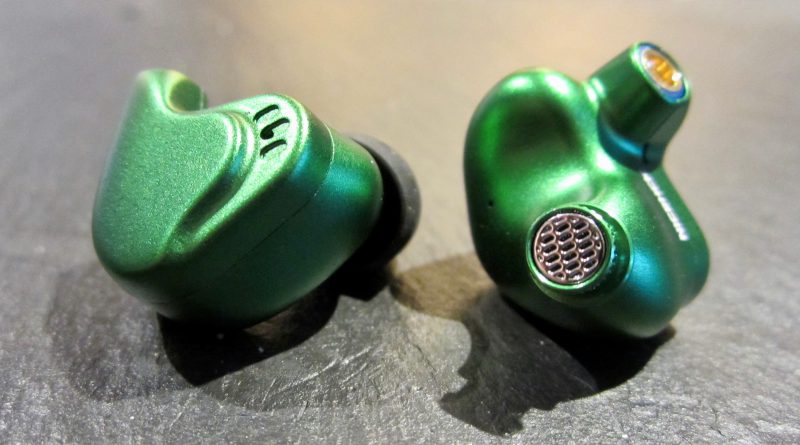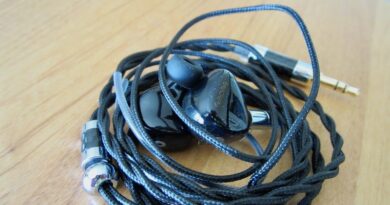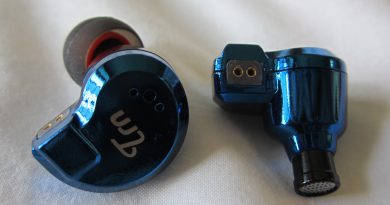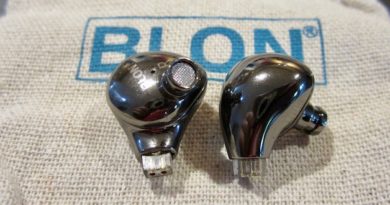NiceHCK M6 Review (1) – Driving Like God In France
![]()
Pros — Beautiful imaging; great resolution and detail; smooth sound.
Cons — Soft, prominent low end is not for everyone; filters can come loose.
![]()
EXECUTIVE SUMMARY
The NiceHCK M6 is a warm-sounding, somewhat low-end-heavy earphone with a V-shaped signature that nevertheless excels by its excellent midrange (voice reproduction, natural timbre), soundstage, resolution, and layering. It is quite a step above the $40–50 earphone fare I have reviewed recently.
![]()
DISCLAIMER
I was asked by Jim NiceHCK to review this earphone and purchased it for $1. I thank Jim for our ongoing discussion, patiently accepting my criticisms and suggestions and his absolute non- interference with my work.
![]()
It is my goal to give the reader a concise, thorough, and accurate account of the earphone – and how the earphone fits the big picture. Packaging and cable shape are of limited importance to me and will not get much attention here. In terms of visualization, I aim to focus on the relevant characteristic features of the earphone including details such as vents, lips, connectors etc. Most photos and diagrams can be enlarged by clicking on them.
![]()
After reading my previous reviews, it should be clear that I prefer a neutral leaning tuning with a tight and dry bass – and certainly not a V-shaped flavour. The higher the price of an earphone, the flatter of a frequency response I expect with the mids moving forward and becoming successively more intimate and natural.
![]()
As always, I tested the NiceHCK M6 over an ever growing cross section of music that provided a broad coverage of the frequency spectrum, including naturally generated sounds such a voices and classical instruments.
![]()
Frequency response curves are now one of my standard staples of information in this price class. As to the graphs displayed here: the measuring coupler was two pieces of plastic tubing on the end of a Dayton iMM-6 microphone. No compensation or smoothing was applied. These measurements should not be directly compared to other measurements except those done on the same device, for example the ones I have posted before.
![]()
INTRODUCTION
NiceHCK is a company that – among other things – sells “original manufacturer design” (ODM) items under their own branding. Recent NiceHCK earphone models include the EP10, EP35, EB2 earbuds, and the P3. The NiceHCK M6 is a higher-priced model and the most upscale iem I have reviewed so far. Therefore let’s explore together what makes the NiceHCK M6 better and more valuable than, let’s say, the $50 class.
![]()
The NiceHCK M6 is a six-driver earphone (2DD + 4BA) with a four-way crossover that was designed and tuned by a “famous” (however mysterious) ODM factory in Guangdong. It appears to be technically identical with the BVGP DMG as both share the same sound description and frequency response. They come most likely from the same assembly line.
![]()
SPECIFICATIONS
- Product Name: Original NICEHCK M6 In Ear Metal Earphone
- Brand: NICEHCK
- Model: M6
- Earphone Type: In-ear
- Driver Unit: 4 BA + 2 DD (4 Balanced Armature + 2 Dynamic) hybrid driver unit Crossover: 4-way
- Impedance: 17Ω
- Earphone Sensitivity: 106 ± 2 dB/mW
- Frequency range: 20 – 20000Hz Plug Type: 3.5mm L-shaped
- Cable Length: 1.2m ± 3cm
- Available Colours: Green, Gray
- Cable Connector: MMCX Remote/Mic: No
- Tested at: $85
Purchase Link: NiceHCK Audio Store
![]()

PACKAGING AND ACCESSORIES
The content comes in a factory-sealed box that contains the standard NiceHCK earphone case will all goodies inside, packaged in a series of small plastic baggies. The content is laid out in the photo.
![]()
PHYSICAL APPEARANCE, HAPTIC, AND BUILD QUALITY
The rounded shells are made of aviation-grade aluminum in a top end “computer numerical control” (CNC) process [according to Jim NiceHCK] and feel smooth and high quality. The shells have a front vent and a back vent, and a third, square one by the connector. The braided MMCX cable is soft and flexible with an L-shaped 3.5 mm connector – and is appearance wise and haptically somewhere between the new KZ cables and the fancier third-party cables. Everything is of good quality.
![]()
ERGONOMICS, COMFORT, ISOLATION, AND FIT
The earpieces fit me well and were comfortable over longer periods of time. Isolation was average but the bassy tuning counteracts the low outside noise frequencies that are hard to filter out (see below).
![]()
SOURCE AND EARTIPS

I listened with the iphone 5S with the audioquest dragonfly black dac/amp attached to it. Although easy to drive with the iphone alone, the M6 greatly benefitted from the dragonfly. The largest included wide-bore tips worked well for me.
![]()
TONALITY AND TECHNICALITIES
The NiceHCK M6 comes with three sets of filters but no manual describing the differences between them. The ones in the shells’ colour (green in my case) are the standard filters: they had to do for me – I don’t like fiddling with filters – and were used for my sound description. According to JimNiceHCK, the golden filters “improve the low frequencies” and the silver ones “improve the high frequencies”. My measurements show no difference between filters up to 1 kHz – but lots of variation between 2 and 6 kHz where the gold filters produce substantially less energy – and the silver filters slightly more – compared to the green reference filters.

![]()
It has been claimed that the NiceHCK M6 sounds better with a more expensive third-party cable (one user reported a tighter bass and another a thicker bass, possibly using the same copper cable). I tried the M6 with five difference cables. If there were any sonic differences, they were minimal – and not based on differences in frequency responses as per my measurements. If an earphone does not work with the stock cable, it is not good imo.

NiceHCK M6 frequency response with 5 different cables.

NiceHCK M6 frequency response with the green reference filters.\
![]()
The NiceHCK M6 is a warm sounding earphone with a V-shaped signature and a pronounced, thick low end. The frequency response is rather linear which results in an overall smooth sound. Unfortunately, the low end and midrange do not harmonize but rather work against each other.
![]()
The sub-bass is well extended but overshadowed by a broad bass (sensu stricto) hump peaking between 60 and 90 Hz. The bass has a reasonably fast attack but a rather slow decay which can make it soupy, soft, and possibly overwhelming to some ears while not being overly impactful – and it is certainly not part of an “audiophile” tuning which I expect in this price range. To me the bass is the sonically weakest point and I wonder what the tuner did to the two DDs. The benefit of such a bass, on the other hand, is added richness to deeper male voices and a good “shield” against the low- frequency travel noise that is not filtered out by the isolation (city bus, airplane). Another advantage of the bass is when combined with a bass-weak dap such as the Shanling M0 (I perceive this player as not very bassy). The M6 introduces some life to the Shanling’s low end. It still does not make the low end any more accurate but certainly generates some fun.
![]()
The midrange is simply great and makes up for the bass: although slightly recessed, voices have an incredibly natural timbre and richness. I have yet to hear better. The bass, however does occasionally smudge into the mids. As to the upper midrange: there is a smaller hump in the 2-4 kHz area than in most cheaper models (e.g. TRN V80, BQEYZ KZ2): this shows that the drivers have enough quality not having to rely on this excess energy that also can cause fatigue through harshness and hardness. The effect in the M6 is that there is no crowding in busy instrumentations but a good flow in these frequencies.
![]()
The treble tags on seemlessly to the mids and they are well extended. High notes are smoothly reproduced without any sibilance or other unpleasant surprises. In “Der Hölle Rache kocht in meinem Herzen”, a grandiose aria from Wolfman Mozart’s opera “Die Zauberflöte”, the “Queen of the Night” hits her high notes firmly and with ease. High quality listening in the uppermost levels.
![]()
Soundstage, sense of space, instrument separation, layering, resolution, and detail are all absolutely superb – although this depends to some degree on the bass presence. I listened to my standard dummyhead spoken-word test tracks and the accuracy of the placement of voices and background sounds was mindboggling. Choir performances and singers on the piano also sounded fantastic. Again, I have not heard an earphone that beats the M6 in this respect – but my experience with pricy current models is limited. Adding a strong bass section reduces these qualities.
![]()
SELECT COMPARISONS
There are not many earphones in this price category I know. I feel that the M6 is unique enough not to rely on detailed comparisons. It should be very clear from my descriptions and the reviews by others whether it is for you.
![]()
iBasso IT01 (~$100): a known bass and sub-bass canon with a generally accepted superb low-end quality that is not even remotely touched by the M6. The M6, on the other hand, smokes the iBasso in the midrange in terms of timbre and richness as well as in overall imaging and resolution. The iBasso comes with a really fancy looking cable.

Frequency responses IT01 and M6.
![]()
Hill Audio S8 ($60): its 2 BA + 1 DD produce a V-shape and warm signature with an soft, bloated bass and a good midrange similar to the M6 but an overall slightly leaner image. The M6 is better resolving with more subtle details and its midrange is fuller, smoother, and less crowded. The S8 is not far behind the M6, sound wise. The S8’s shells are smaller and may be better fitting for some ears. If you like the S8, you will like the M6 (and the other way round).

Frequency responses S8 and M6.
![]()
Brainwavz B200 v1 (~$110; discontinued): this 2 BA earphone has a tight bass, not quite as well extended into the sub-bass as in the M6, a slimmer, cooler sound than M6 and S8, but it lacks the rich, natural midrange of the M6. Build is soso at best but the fit of the small earpieces is magical. Technically less competent than the M6 it may nevertheless have attracted many purists.

Frequency responses B200 v1 and M6.
![]()
BCEYZ KC2 (~$50): this 2 + 2 hybrid has a slimmer, faster bass but is also leaner and less natural in the voice department and less smooth/shouty in the upper midrange. The M6 offers simply “more sound and soundstage” and a better resolution. The KC2, while a respectable earphone, is the least capable of this mix.

Frequency responses K2 and M6.
![]()
CONCLUDING REMARKS
The NiceHCK M6 is a good, technically competent earphone that is well worth its asking price [the current asking price of $88 is ridiculously low] but it could be a killer if the tuner tightened up the rustic low end. The all-important midrange is of such a high quality that even the small recession can’t take much away from it. Nevertheless, focusing and reducing the bass would bring out even more clarity, detail, and resolution and add balance to the sound signature. I asked Jim to forward my suggestions to his “famous” ODM factory hoping for a second, alternatively tuned version as offered, for example, by Etymotic.
![]()
Summing up, the NiceHCK M6 is like a large luxury SUV: roomy and comfortable, offering a smooth ride on a soft suspension. While some of us like this, others prefer the tighter suspension of a sports car. Nevertheless does the ride remain much slicker and more comfortable with the M6 than with a $50 SUV. The road appears to be wider and more open to the driver.
![]()
In the end, it comes down to a matter of taste. Looking at the FR graph alone may be a deal-maker or -breaker for the informed reader.
You can get the NiceHCK M6 only here!
![]()
UPDATE 2019-01-31:
I added these third-party filters which removed a lot of bass quantity — but it preserved the bass’s slow decay. This brought the mids forward and improved the balance immensely. The overall sound is still pretty meaty and analog.
![]()



Our other NiceHCK M6 review:





